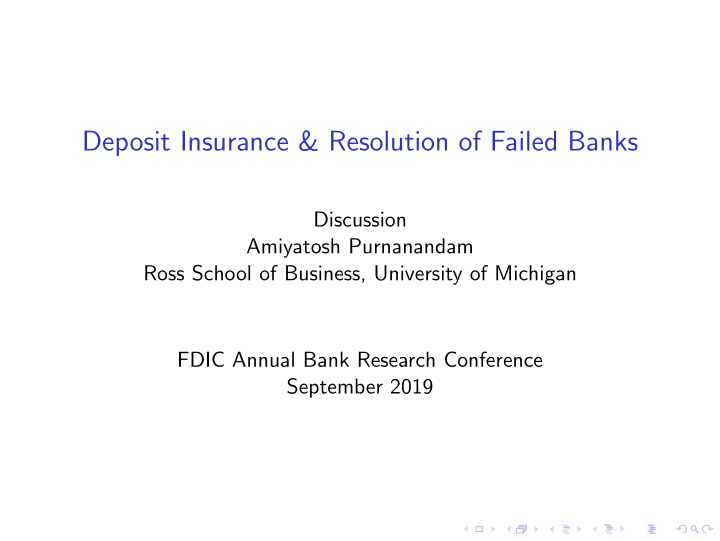



Deposit Insurance & Resolution of Failed Banks Discussion Amiyatosh Purnanandam Ross School of Business, University of Michigan FDIC Annual Bank Research Conference September 2019
Key Theme Two very interesting papers on the interaction between deposit insurance and bank’s incentives related to: ◮ Activities in the Fed Funds Market ◮ Bidding for Failed Banks
Key Theme Two very interesting papers on the interaction between deposit insurance and bank’s incentives related to: ◮ Activities in the Fed Funds Market ◮ Bidding for Failed Banks ◮ Lots of work on the effects of deposit insurance on risk-taking. ◮ But not much on these other dimensions. ◮ Very relevant papers for Deposit Insurance Policies.
Deposit Insurance Premiums & Arbitrage Key Idea ◮ Interest on Excess Reserve ↑ → Demand for short-term funds (e.g., by banks from GSE) ↑ → Short term rate ↑ ◮ However, bank size goes up as a result, leading to higher deposit insurance premium. ◮ Profitability of IOER arbitrage goes down and thus DIP works as an offsetting force. ◮ Crucial to understand the effect of DIP on the supply and demand for federal funds. ◮ Good work on exploiting kink in assessment of deposit insurance.
Deposit Insurance Premiums & Arbitrage: Comments ◮ Maybe useful to relate to the literature on limits to arbitrage and ask a bigger question ◮ Why don’t the IOER and Effective Fed Funds Rate converge? ◮ In fact IOER ≥ Effective Fed Funds Rate. Why?
Deposit Insurance Premiums & Arbitrage: Comments ◮ Maybe useful to relate to the literature on limits to arbitrage and ask a bigger question ◮ Why don’t the IOER and Effective Fed Funds Rate converge? ◮ In fact IOER ≥ Effective Fed Funds Rate. Why? ◮ What frictions are at play and how important is DIP compared to other potential frictions: capital requirement, transactions costs?
Deposit Insurance Premiums & Arbitrage: Comments ◮ Maybe useful to relate to the literature on limits to arbitrage and ask a bigger question ◮ Why don’t the IOER and Effective Fed Funds Rate converge? ◮ In fact IOER ≥ Effective Fed Funds Rate. Why? ◮ What frictions are at play and how important is DIP compared to other potential frictions: capital requirement, transactions costs? ◮ It will be important to look at the behavior of large banks.
Resolving Failed Banks Key Idea ◮ FDIC’s resolution mechanism is complex: ◮ Flexibility: allows multiple dimensions of bidding. ◮ Opacity: uncertainty about the scoring rule.
Resolving Failed Banks Key Idea ◮ FDIC’s resolution mechanism is complex: ◮ Flexibility: allows multiple dimensions of bidding. ◮ Opacity: uncertainty about the scoring rule. ◮ A rigorous structural model to back out the valuation of bidders from observed bid. ◮ Quantity losses to FDIC using alternate mechanism. ◮ Key message: FDIC can lower its resolution cost by 17% by eliminating opacity in scoring rule!
Resolving Failed Banks: Comments ◮ The effect of uncertainty in scoring rule in the model: ◮ Bidders can submit multiple bid and hope to win for some combination of bids and scoring rule. ◮ Low-valuation bidders can bid even less hoping that a good shock will allow them to win anyway.
Resolving Failed Banks: Comments ◮ The effect of uncertainty in scoring rule in the model: ◮ Bidders can submit multiple bid and hope to win for some combination of bids and scoring rule. ◮ Low-valuation bidders can bid even less hoping that a good shock will allow them to win anyway. ◮ Question: Is there any benefit to lack of transparency in scoring rule that is not captured in the model? ◮ What if the auction fails with transparent rule?
Resolving Failed Banks: Comments ◮ The effect of uncertainty in scoring rule in the model: ◮ Bidders can submit multiple bid and hope to win for some combination of bids and scoring rule. ◮ Low-valuation bidders can bid even less hoping that a good shock will allow them to win anyway. ◮ Question: Is there any benefit to lack of transparency in scoring rule that is not captured in the model? ◮ What if the auction fails with transparent rule? ◮ Rule-bound versus discretion? ◮ Importance of hard versus soft information? ◮ Rule-bound model may attract different/more bidders. ◮ Multiple resolution at the same time: capacity constraints/legal constraints.
Conclusions ◮ Papers are tackling very important issues ◮ Some work remains in terms of digging deeper into the issues. ◮ Good luck!
Recommend
More recommend